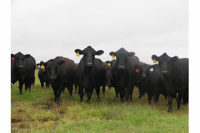The Chase to Trace
By Lisa White
Complete traceability of product may be the desired end result, but the meat industry’s systems and technologies have lagged behind.
Although there has been an increased focus on traceability in the meat and poultry industry in recent years, experts say there have not been any notable advancements in technology or systems designed to expedite recalls and enhance food safety.
“Traceability is a very interesting term,” says Mike John, president of The National Cattleman’s Beef Association. (NCBA). “There is so much confusion when people talk about animal identification. Is it tracking the cattle when it changes hands or tagging their ears for identification? At every juncture, there is some challenge or technological inefficiency that is keeping us from tracing product. And if you’re a packer, you don’t want traceability to go beyond the hooked carcass because tracking a cut after processing 12,000 rounds a day would be difficult.”
Despite the slow progress, there have been developments. The state of Michigan appointed a task force about a year and a half ago to deal with radio frequency identification (RFID) in livestock to enhance traceability. Consisting of state regulatory officials and industry representatives, the group was assembled in response to tuberculosis found in the region’s white tail deer. According to Edward C. Mather, deputy director of the National Food Safety and Toxicology Center at Michigan State University in East Lansing, Mich., “This becomes an issue for the livestock industry and public-health sector.”
As a result, all Michigan livestock is required to have implanted electronic tags by March 1, 2007. At presstime, chip readers had already been installed, 423,000 tags were sold and monitoring equipment was already in place. Mather says the initiative is supported by Michigan’s livestock producers and the state’s major livestock operations, including the Michigan Cattleman’s Association, Michigan Pork Producers and farmers.
“Livestock owners and the industry realize this legislation is in their best interest and that Michigan will be a model for other states,” he says.
The Michigan law is the first of its kind that imposes this type of legislation, and many predict it will not be the last. “We will see [more legislation like this in the future],” John says, adding that this is a state, and not a federal, issue.
As RFID technology becomes more affordable, many predict it will become more prevalent. Ranzell “Nick” Nickelson II, Ph.D., chief executive for science and health at Standard Meat Company in Saginaw, Texas, sees more and more companies using these systems.
“It is still a capital investment, and we are still evaluating the system to see how it links into our customers’ programs to help with inventory,” he says. The biggest issue for meat suppliers is recall time. Nickelson says with today’s technologies, the expectation for recall times has been reduced to two hours or less.
“We are not happy unless we can accomplish a recall in less than 30 minutes,” he explains. “The Internet demands a more rapid response from the industry. Eventually, we would like to reduce our recalls to a case level, with each case having its own RFID tag. This way, we could do recalls at the stores.”
Issues with beef
One of the obstacles with traceability is that some products, such as ground beef, may be sourced from a number of suppliers. Gary Ades, Ph.D., president of G&L Consulting Group in Bentonville, Ark., says, in these cases there needs to be more control of the sources. This is where N60 testing, or statistical reliability tests, come in.
“You want to do the best statistical testing you can to make sure product coming in the door is clean,” he says. “In a recall situation, you want to try and find either [the contaminated] finished product or ingredients used in a certain amount of time and with as close to 100 percent accuracy as possible.”
The real issue, according to John Paterson, extension beef specialist at the Montana Beef Network, is that companies want cattle that are both age- and source-verified [for easier traceability].
“Last year, we age- and source-verified 55,000 calves,” he adds. “This involves going out to the ranch and verifying the animals’ records using a third-party auditing certification. Verification is done through a Processed Source Program, or PSP.”
All data is electronically stored and verified. With this system, an animal originating from Montana that falls ill in Iowa can be identified in about two minutes using its RFID tag number. Currently, 200 Montana ranchers participate in this program.
“We have a system that works very well and offers good traceback. It should be a model in the industry because it is a very simple program,” Paterson says.
Other traceback technologies primarily used by Montana ranchers for exports due to their higher cost include retinal scanning and DNA sampling. Unfortunately, most of the technology stops at the packing plant because it is difficult to transfer data when product hits the coolers.
“Ideally, we would like to get further into the packing plant than the cooler, going all the way to the cutting table or the box with DNA technology,” Paterson says. “This would give us the ability to have full traceability at a low cost.”
John confirms that, as far as traceability goes, the industry has not made the progress expected.
“The USDA took a different road, changing projections and expectations,” he explains. “It has taken a stance to keep premise registration and the identification process voluntary, while making efforts to explain to producers the value of this program.”
Still, there has been a lack of participation by a lot of meat producers with premise registration, which requires producers to obtain an identification number from their state agency that is linked to the USDA’s premise allocator. This provides information on the breed of livestock, the producer’s contact information and its exact location in the event of a disease outbreak.
The USDA currently has more than 300,000 premises registered, and seeks to have 25 percent of the nation’s producers participating in the program within the next few months. At the current pace, it is anticipated that they will fall short of this goal, but the NCBA and other organizations will be assisting them in registration.
“We need to convince people that it is not an intrusion into their information, but a way to accumulate information to protect the public from animal disease,” John says.
In addition to Michigan, the Kansas Livestock Association recently passed a resolution asking for mandatory statewide premise registration. Unlike premise registration, there has been growing participation in the identification programs due to market factors.
“This is mainly due to the trade agreement with Japan that requires source-verified cattle,” John says. “Producers with branded or value-added programs, like Angus and natural meats, also are more apt to participate because they receive returns on their investments in traceability.”
Pork and poultry
Unlike beef, traceability is not as big an issue in the poultry industry because that industry is vertically integrated. Farms typically raise birds for one plant or one customer. Birds are picked up and delivered to the plant on the same day. Lot numbers on the packages trace birds back to the farm.
“As far as poultry, we can go back to the flock,” Ades says. “We populate, draw from and process poultry from each house in a certain timeframe.”
Still, The National Chicken Council, based in Washington, D.C., is working with the USDA on developing a better tracking system for the nation’s poultry supply. According to Richard Lobb, the council’s director of communications, the finished product is still a few years down the road.
“When it is developed, the system will allow the poultry industry and government to determine what flocks may be in the affected areas with an outbreak,” he says.
In the pork industry, all of the pigs destined for the packing plants can be traced back to the producer or farm.
“We have used this process for disease-management purposes, both management on the farm as well as disease irradication built around the ability to track from the plant to the heard of origins,” says Dr. Paul Sundberg, vice president of science and technology at The National Pork Board.
Like the NCBA, the Pork Board has been advocating premise identification as a mechanism for producers to address health concerns of animals as well as a way to protect the industry from highly contagious diseases.
Sundberg says it is important to distinguish between traceability and trackability. “Traceability is important, but too often we see the assumption that meat can be traced from the table back to the farm of origin. That is possible in some cases, but not common in our industry. And, as far as food safety is concerned, it is not necessary,” he says. “The U.S. has a system in place that enables us to link the farm to the packing plant and the packing plant to the consumer. This is accomplished without a costly effort of traceability, which may be more of a marketing issue than an animal or public-health issue.”
Although much of the pork industry does not currently utilize RFID technology, it does employ visual-identification devices, such as ear or bangle tags. “We are trying to figure out how to best use these as premise identification tools or individual identification information that can be collected at plants to solve and understand animal-health issues,” Sundberg says.
In the meantime, Ades recommends that companies perform traceability mock recalls at least twice a year, preferably quarterly, with the goal to find a product’s origin within two to four hours.
“If you have a problem, you should be able to find the product,” he says. “When mock recalls are not done, the process can get sloppy and the proper systems will not be in place. By doing this, company’s can figure out where the gaps are and fill them in. The paperwork needs to be available to track product and contact information on the appropriate people needs to be easily accessed. The key is to determine the risk, keep testing the systems and make sure they work.”
The onus, will lie upon the industry, especially since many predict the federal government will continue holding back from making recalls mandatory.
“The industry has always gone along with voluntary recalls,” Nickelson says. “Many believe if you publish too much information or the wrong information, consumers will bring product back that is not part of the recall. This only adds confusion to the problem and could present even more risk to consumers by clouding the issue.”
As far as the future of traceability is concerned, John says the technology will have to improve to get more business segments to embrace it.
Still, traceability and consumer confidence should not be tied together, says John.
“We have a food-safety inspection system that makes our food supply the safest in the world, and to imply that traceability will improve that is ridiculous,” he says.



Report Abusive Comment